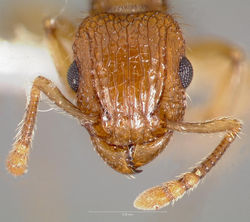Key to US Tetramorium species
Key to Tetramorium species of the United States based on workers, modified from Bolton (1979).
This key contains Tetramorium tortuosum group species and introduced species. It does not include Tetramorium atratulum, a workerless social parasite of Tetramorium immigrans.
You may also be interested in
- Checklist of Tetramorium species of United States
- The Tetramorium tortuosum species group
- Key to Tetramorium tortuosum-group species of the New World
- Tetramorium
1
2
- Eyes relatively large, maximum diameter 0.26 x head width at minimum, usually more. Hairs on pronotal dorsum and on upper frontal carinae short and straight, usually stubble-like, shorter than the maximum diameter of the eye. (Texas, Arizona) => Tetramorium hispidum
- Eyes relatively small, maximum diameter 0.25 x head width at maximum, usually less. Hairs on pronotal dorsum and on upper frontal carinae long, fine and often curved, many of them longer than the maximum diameter of the eye. (Texas, Arizona and northern Mexico) => Tetramorium spinosum
3
- Dorsum of head and mesosoma with a thick coat of soft erect hairs, some of which are branched into two or three tips => Tetramorium lanuginosum
- Dorsum of head and mesosoma with sparse to abundant but never thick hairs, none of which are branched => 4
4
- Hairs on promesonotal dorsum sparse, uniformly short, stout and blunt; the longest of them much shorter than the maximum diameter of the eye => 5
- Hairs on promesonotal dorsum dense, uniformly elongate, slender and acute apically; the longest of them at least as long as the maximum diameter of the eye => 6
5
- Frontal carinae strongly developed throughout their length, sinuate, running unbroken almost to the occipital margin and surmounted throughout their length by a narrow raised rim or flange. The whole of the frontal carinae much more strongly developed than the remaining cephalic rugulae. Ground-sculpture of head between frontal carinae strongly granular or reticulate-punctulate, the surfaces matte. Antennal scrobes shallow but broad and conspicuous. (Cosmopolitan tramp species) => Tetramorium simillimum
- Frontal carinae more feebly developed, weakly or not sinuate, most strongly developed to level of midlength of eye behind which they become very weak, or broken, or gradually fade out posteriorly; not surmounted by a raised rim or flange beyond the level of the midlength of the eye, behind which the carinae are faint. Ground-sculpture of head between carinae feeble, the surfaces dully shining. Antennal scrobes vestigial. (Tramp species mostly in tropics and subtropics) => Tetramorium caldarium
6
- Dorsum of head behind level of eyes with regular longitudinal rugulation, without a rugoreticulum occipitally => Tetramorium immigrans (widespread, monogynous colonies), Tetramorium tsushimae (urban areas of Missouri and Illinois, polygynous colonies)
- Dorsum of head behind level of eyes with a coarse rugoreticulum, at least occipitally => 7
7
- Mandibles sculptured with fine dense longitudinal striation or dense shagreening. Hairs on upper surface of frontal carinae between antennal insertions and occipital corners shorter than maximum diameter of eye. Head and mesosoma yellow-brown to bright orangebrown, gaster much darker, blackish brown. (Cosmopolitan tramp species; widespread in Neotropics) => Tetramorium bicarinatum
- Mandibles smooth and shining with scattered pits. Hairs on upper surface of frontal carinae between antennal insertions and occipital corners longer than maximum diameter of eye. Uniformly yellow or dark brown species, not bicoloured as above => 8
8
- Uniformly clear yellow to light orange-brown, usually with the gaster lighter in shade than the mesosoma. First gastral tergite without basal costulae => Tetramorium insolens
- Uniformly dark brown or blackish brown. First gastral tergite with basal costulae => Tetramorium pacificum
References
- Bolton, B. 1979. The ant tribe Tetramoriini (Hymenoptera: Formicidae). The genus Tetramorium Mayr in the Malagasy region and in the New World. Bull. Br. Mus. (Nat. Hist.) Entomol. 38: 129-181.



















